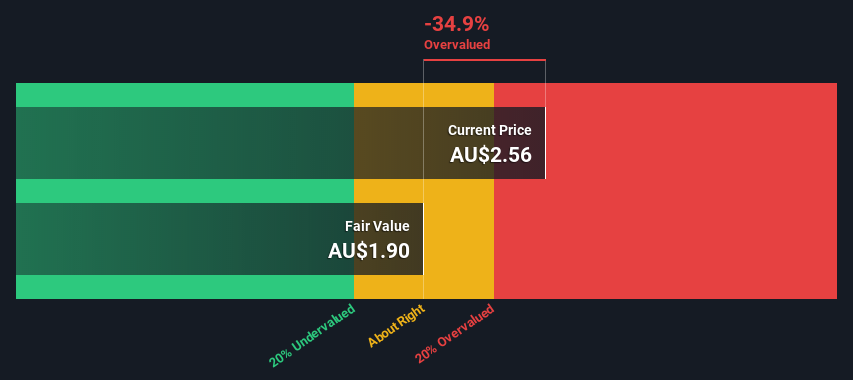- Australia
- /
- Medical Equipment
- /
- ASX:PNV
Is PolyNovo Limited (ASX:PNV) Worth AU$2.6 Based On Its Intrinsic Value?

Today we'll do a simple run through of a valuation method used to estimate the attractiveness of PolyNovo Limited (ASX:PNV) as an investment opportunity by taking the forecast future cash flows of the company and discounting them back to today's value. Our analysis will employ the Discounted Cash Flow (DCF) model. Before you think you won't be able to understand it, just read on! It's actually much less complex than you'd imagine.
Companies can be valued in a lot of ways, so we would point out that a DCF is not perfect for every situation. If you want to learn more about discounted cash flow, the rationale behind this calculation can be read in detail in the Simply Wall St analysis model.
View our latest analysis for PolyNovo
Step By Step Through The Calculation
We use what is known as a 2-stage model, which simply means we have two different periods of growth rates for the company's cash flows. Generally the first stage is higher growth, and the second stage is a lower growth phase. To start off with, we need to estimate the next ten years of cash flows. Where possible we use analyst estimates, but when these aren't available we extrapolate the previous free cash flow (FCF) from the last estimate or reported value. We assume companies with shrinking free cash flow will slow their rate of shrinkage, and that companies with growing free cash flow will see their growth rate slow, over this period. We do this to reflect that growth tends to slow more in the early years than it does in later years.
A DCF is all about the idea that a dollar in the future is less valuable than a dollar today, and so the sum of these future cash flows is then discounted to today's value:
10-year free cash flow (FCF) forecast
| 2023 | 2024 | 2025 | 2026 | 2027 | 2028 | 2029 | 2030 | 2031 | 2032 | |
| Levered FCF (A$, Millions) | -AU$5.00m | -AU$1.00m | AU$16.0m | AU$27.4m | AU$41.3m | AU$56.2m | AU$70.6m | AU$83.8m | AU$95.2m | AU$104.8m |
| Growth Rate Estimate Source | Analyst x1 | Analyst x1 | Analyst x1 | Est @ 71.41% | Est @ 50.57% | Est @ 35.98% | Est @ 25.76% | Est @ 18.61% | Est @ 13.61% | Est @ 10.10% |
| Present Value (A$, Millions) Discounted @ 7.2% | -AU$4.7 | -AU$0.9 | AU$13.0 | AU$20.8 | AU$29.2 | AU$37.0 | AU$43.5 | AU$48.1 | AU$51.0 | AU$52.4 |
("Est" = FCF growth rate estimated by Simply Wall St)
Present Value of 10-year Cash Flow (PVCF) = AU$289m
The second stage is also known as Terminal Value, this is the business's cash flow after the first stage. The Gordon Growth formula is used to calculate Terminal Value at a future annual growth rate equal to the 5-year average of the 10-year government bond yield of 1.9%. We discount the terminal cash flows to today's value at a cost of equity of 7.2%.
Terminal Value (TV)= FCF2032 × (1 + g) ÷ (r – g) = AU$105m× (1 + 1.9%) ÷ (7.2%– 1.9%) = AU$2.0b
Present Value of Terminal Value (PVTV)= TV / (1 + r)10= AU$2.0b÷ ( 1 + 7.2%)10= AU$1.0b
The total value, or equity value, is then the sum of the present value of the future cash flows, which in this case is AU$1.3b. In the final step we divide the equity value by the number of shares outstanding. Compared to the current share price of AU$2.6, the company appears reasonably expensive at the time of writing. Remember though, that this is just an approximate valuation, and like any complex formula - garbage in, garbage out.

Important Assumptions
Now the most important inputs to a discounted cash flow are the discount rate, and of course, the actual cash flows. If you don't agree with these result, have a go at the calculation yourself and play with the assumptions. The DCF also does not consider the possible cyclicality of an industry, or a company's future capital requirements, so it does not give a full picture of a company's potential performance. Given that we are looking at PolyNovo as potential shareholders, the cost of equity is used as the discount rate, rather than the cost of capital (or weighted average cost of capital, WACC) which accounts for debt. In this calculation we've used 7.2%, which is based on a levered beta of 0.884. Beta is a measure of a stock's volatility, compared to the market as a whole. We get our beta from the industry average beta of globally comparable companies, with an imposed limit between 0.8 and 2.0, which is a reasonable range for a stable business.
SWOT Analysis for PolyNovo
- Debt is well covered by .
- Interest payments on debt are not well covered.
- Expensive based on P/S ratio and estimated fair value.
- Shareholders have been diluted in the past year.
- PNV's financial characteristics indicate limited near-term opportunities for shareholders.
- Debt is not well covered by operating cash flow.
- Has less than 3 years of cash runway based on current free cash flow.
Looking Ahead:
Although the valuation of a company is important, it ideally won't be the sole piece of analysis you scrutinize for a company. DCF models are not the be-all and end-all of investment valuation. Preferably you'd apply different cases and assumptions and see how they would impact the company's valuation. For example, changes in the company's cost of equity or the risk free rate can significantly impact the valuation. What is the reason for the share price exceeding the intrinsic value? For PolyNovo, we've put together three pertinent factors you should further examine:
- Risks: Every company has them, and we've spotted 1 warning sign for PolyNovo you should know about.
- Future Earnings: How does PNV's growth rate compare to its peers and the wider market? Dig deeper into the analyst consensus number for the upcoming years by interacting with our free analyst growth expectation chart.
- Other Solid Businesses: Low debt, high returns on equity and good past performance are fundamental to a strong business. Why not explore our interactive list of stocks with solid business fundamentals to see if there are other companies you may not have considered!
PS. Simply Wall St updates its DCF calculation for every Australian stock every day, so if you want to find the intrinsic value of any other stock just search here.
New: Manage All Your Stock Portfolios in One Place
We've created the ultimate portfolio companion for stock investors, and it's free.
• Connect an unlimited number of Portfolios and see your total in one currency
• Be alerted to new Warning Signs or Risks via email or mobile
• Track the Fair Value of your stocks
Have feedback on this article? Concerned about the content? Get in touch with us directly. Alternatively, email editorial-team (at) simplywallst.com.
This article by Simply Wall St is general in nature. We provide commentary based on historical data and analyst forecasts only using an unbiased methodology and our articles are not intended to be financial advice. It does not constitute a recommendation to buy or sell any stock, and does not take account of your objectives, or your financial situation. We aim to bring you long-term focused analysis driven by fundamental data. Note that our analysis may not factor in the latest price-sensitive company announcements or qualitative material. Simply Wall St has no position in any stocks mentioned.
About ASX:PNV
PolyNovo
Designs, manufactures, and sells biodegradable medical devices in the United States, Australia, New Zealand, and internationally.
High growth potential with excellent balance sheet.
Market Insights
Community Narratives




